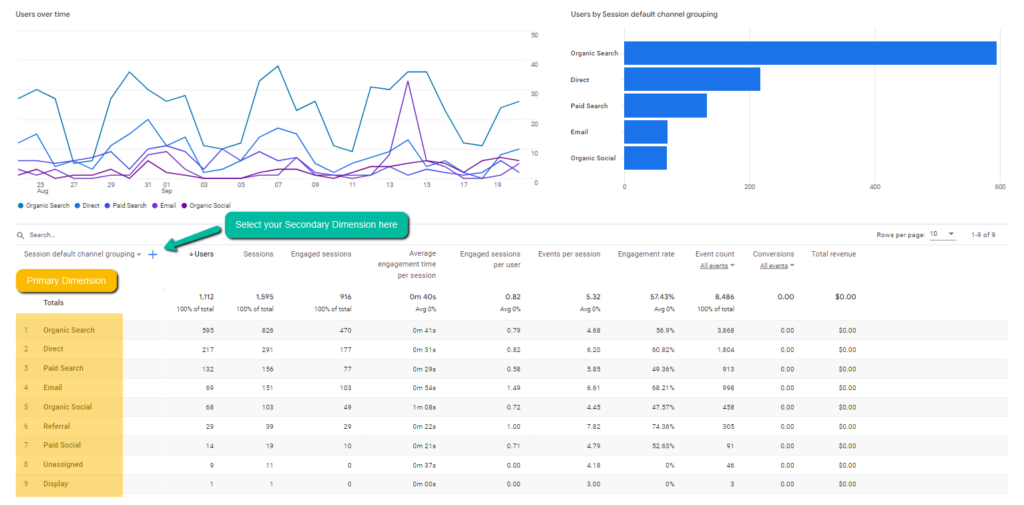Mastering Secondary Dimension in Google Analytics: A Complete Guide
Mastering Secondary Dimension in Google Analytics: A Complete Guide
Blog Article
Enhance Your Data Evaluation Making Use Of Additional Dimension in Google Analytics
Exploring the capacities of second dimensions in Google Analytics opens up a realm of opportunities for refining information analysis. By layering additional measurements onto main data sets, a more elaborate narrative arises, dropping light on individual interactions and performance indicators.
Comprehending Additional Dimensions
In the realm of information analysis, an essential element to grasp is the principle of second dimensions and their relevance in removing much deeper insights from Google Analytics records. Second measurements in Google Analytics refer to extra criteria that can be included to the main measurement, allowing for a more detailed analysis of information. By including secondary measurements, experts can sector and filter data to uncover patterns, fads, and correlations that may not appear when checking out the data in its entirety. These secondary dimensions can supply context and an extra detailed understanding of individual behavior, website traffic resources, and other vital metrics tracked by Google Analytics.

Advantages of Using Secondary Dimensions
When evaluating data in Google Analytics, the usage of secondary dimensions supplies important understandings into customer actions and performance metrics. By adding a second dimension to your main information, you can dive much deeper into the attributes of your site site visitors and their interactions. Among the key benefits of using additional measurements is the capacity to section and compare information better. This segmentation allows you to comprehend how various variables, such as demographics or traffic resources, effect user habits and conversions (Secondary Dimension in Google Analytics).
Furthermore, additional dimensions help in identifying patterns and relationships that may not be instantly evident when taking a look at the information alone. This deeper degree of evaluation can discover important information that can assist advertising strategies, site optimization, and total business decisions. In addition, additional measurements boost the context of your primary data, giving a more extensive sight of user involvement and performance metrics. On the whole, making use of additional dimensions in Google Analytics can substantially enhance the deepness and quality of your information evaluation, resulting in even more enlightened decision-making and enhanced end results.
Exactly How to Include Second Dimensions
By including additional measurements in Google Analytics, customers can get deeper understandings right into their information evaluation procedure, allowing for even more comprehensive analysis of customer actions and performance metrics. Including secondary measurements is a straightforward procedure that can read what he said substantially boost the deepness of analysis. Once in the report, situate the "Second measurement" tab over the data table.
Studying Data With Additional Dimensions
Making use of second dimensions in information analysis gives a more extensive understanding of individual habits and efficiency metrics. By adding a second measurement to your key information embeded in Google Analytics, you can dig deeper right into the attributes of your web site visitors and their interactions. Combining the primary measurement of click for more info 'source/medium' with the secondary dimension of 'landing web page' can disclose which specific web pages are drawing in website traffic from different resources, assisting you maximize these pages for far better interaction.

In essence, assessing data with secondary measurements empowers you to acquire valuable understandings right into customer actions, determine trends, and make informed choices to enhance the efficiency of your electronic properties.
Finest Practices for Additional Dimensions
In information evaluation, integrating secondary dimensions effectively can substantially boost the deepness of insights derived from metrics and customer actions patterns. When making use of additional measurements in Google Analytics or any various other analytical tool, it is vital to stick to finest techniques to make sure see this site the accuracy and relevance of the information analysis.
One secret best method is to very carefully select additional measurements that enhance the key dimension being examined. Choosing additional dimensions that give extra context or more division can use an extra comprehensive understanding of the data. It is likewise necessary to prevent overcomplicating the analysis by including a lot of additional measurements, which may bring about complication or dilution of understandings.
In addition, it is suggested to explore various combinations of primary and additional dimensions to discover brand-new correlations and fads. On a regular basis assessing and refining the choice of second dimensions based on the specific objectives of the analysis can cause even more actionable understandings. By adhering to these finest practices, data analysts can utilize secondary measurements efficiently to improve the total data evaluation process and decision-making capacities.

Conclusion
To conclude, integrating secondary measurements in Google Analytics is necessary for an extensive information evaluation approach. By leveraging second dimensions along with main ones, online marketers and experts can reveal valuable insights and correlations that can inform decision-making and optimize electronic marketing strategies. Comprehending how to successfully make use of second dimensions and following best practices will certainly allow professionals to draw out purposeful information and enhance their overall performance metrics.
Secondary dimensions in Google Analytics refer to added criteria that can be included to the key dimension, allowing for a much more thorough evaluation of information. By integrating additional measurements, experts can segment and filter data to uncover patterns, patterns, and correlations that may not be noticeable when looking at the data as a whole. Integrating the key dimension of 'source/medium' with the second measurement of 'landing web page' can reveal which details pages are bring in traffic from different resources, aiding you maximize these web pages for much better engagement.
One trick finest method is to meticulously select secondary measurements that enhance the primary dimension being analyzed. By following these best techniques, data experts can take advantage of second measurements properly to enhance the total data evaluation process and decision-making capacities.
Report this page